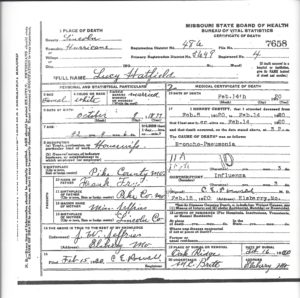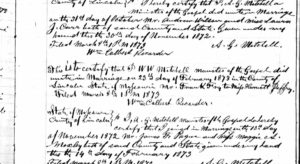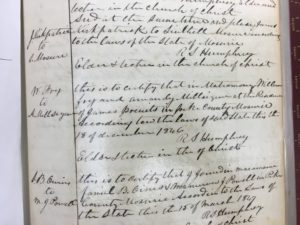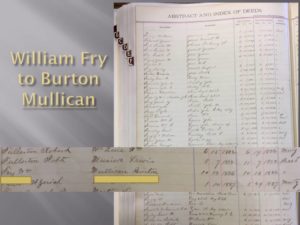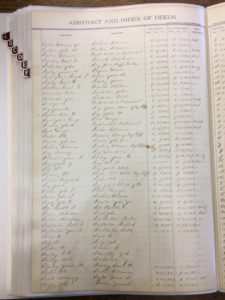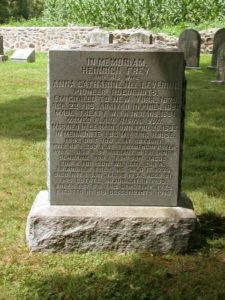How I used DNA to solve my FRY family mystery.
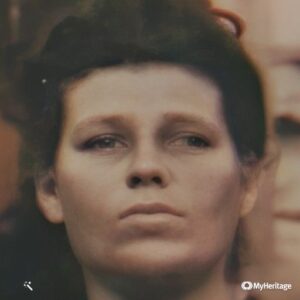
Heinrich _Henry_ Frey to Elaine Hatfield
In 2012, I was contacted by Hilda FRY, who was compiling a book on her husband Darrel’s FRY family. She had no information on my great-great-grandmother Lewellen (FRY) HATFIELD until she found my Heritage Lady website after an online search. I gave Hilda information about Lewellen, and on Christmas Eve of 2012 I opened my mail to find a copy of Hilda’s book, which she had mailed to me. On the inside cover was a photo of Lewellen’s father, Frank FRY, and his wife Harriett (JEFFERIES) FRY. I was thrilled to receive a wonderful Christmas gift of photos of my ancestors!
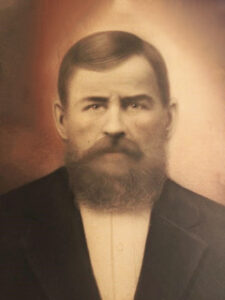
The book stated that Frank was born in Germany, but there was no additional information about his ancestors, so I wanted to know more. I had never done research on Lewellen’s FRY family, so I started researching on Ancestry.com and found a Benjamin Franklin FRY, son of William Keller FRY and America KERBY. The dates and documents, including census records, seemed to fit that of my Frank FRY, so I made the incorrect assumption that Benjamin Franklin FRY was my ancestor.
I then found a website for the Heinrich Frey Family Association (HFFA). I contacted a member of HFFA and was told that William Keller FRY could NOT be my ancestor because he had never married a woman named Harriett JEFFERIES.
I looked on the HFFA website and found a list of several men who were members of the HFFA, along with their Y-DNA test results. I decided that I would ask my cousin, Darrel FRY, if he would take a Y-DNA test. I ordered the test and his results confirmed that he was indeed a descendant of Heinrich FREY. And recently, Richard FREY of the HFFA confirmed that Darrel had the mutation of other men who descend from Benjamin FREY, son of Heinrich. I then had Darrel’s test extended to include an autosomal test. Darrel matched me at 142 centimorgans (cM), my father at 347 cM, my sister at 251 cM, and another Hatfield cousin at 288 cM. That proves that I am indeed a descendant of Heinrich FREY!
So who, then, is Frank Fry’s father? Researching that FRY line proved to be a challenging task that has taken me years to discover. I took a trip to my hometown St. Louis, Missouri, to visit family, and I visited the genealogy room of the St. Louis County Library. Knowing that Frank FRY had lived in Pike County, I searched all of the Pike County, Missouri, records for any FRYS in Pike County.
The 1880 census of Pike County includes Frank FRY with wife Harriette and their four children, including Lou E (Lewellen), aged 2. The census confirmed that Frank was born in Missouri, not Germany, and that his father was born in Kentucky, which was another new clue.

Lewellen’s death certificate shows her father as Frank FRY, born in Missouri.
Lewellen (Fry) Hatfield’s death certificate
I also went to the Pike County Courthouse twice and found the marriage certificate for Frank FRY and Harriette JEFFREY (JEFFRIES), dated November 30, 1872.
Marriage record of Frank Fry and Miss Harriett Jeffreys
I decided to join the Pike County Genealogical Society, and their website listed four FRY family researchers. I contacted them and learned that two were not biologically related, so they had no information on my Frank FRY. The other two women did have FRY family in Pike County. We exchanged information and one of the women, Karen, said she lived in Columbia, Missouri, which is where my oldest son lives! I was headed to Columbia, so I visited her. She is a descendant of James FRY and Elizabeth BAXTER, so we are 5th cousins, once removed. She told me that she had discovered a guardianship document that I should look for. And she found a marriage document for William FRY and Amanda MILLSIZUM (or MILLSIZURR) in the Pike County records, so she thought they could be Frank’s parents.
Marriage record of William Fry and Amanda Millsizum (or Millsizurr)
I found the guardianship documents on FamilySearch. But why would there have been a guardianship? I discovered that there would have been a guardian appointed if there was property owned by the deceased father, regardless of whether or not the mother was still living. So now I needed to find out if William FRY ever owned property. In the Pike County Courthouse I found a deed between William FRY and Buton MULLICAN, dated October 12, 1836.
Finding NO other record anywhere in the USA for a Millsizurr/Millsizum or Millsizen a researcher told me to look at Burton Mullican as the possible name for Amanda. And upon examination of other documents, I found a deed between William Fry and Burton Mullikin also spelled Mullican and Millican in other documents.)
I also found a marriage certificate for Mrs. Amanda FRY and William MIDDLETON, dated April 13, 1852, so it’s obvious that Amanda’s first husband, William FRY, had already died.

In the State Historical Society of Missouri records in Columbia, Missouri, I found the 1850 Mortality Schedule for Pike County (not available on Ancestry.com or anywhere else that I could find online) and discovered that William FRY had died in February 1850, sadly just one month before Frank FRY was born.
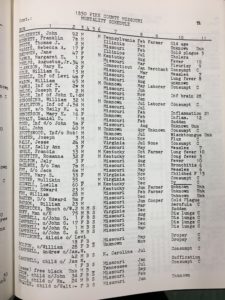
Since death certificates were not required until sometime in 1850, I found no official record of William’s death. And there was no death certificate for Frank FRY either, despite the fact that he died in 1908.
I examined the two guardianship documents for Frank FRY and looked at the names of all persons listed on that document. The first guardianship document was dated Dec. 12, 1860, and was for the minor child James Franklin FRYE.
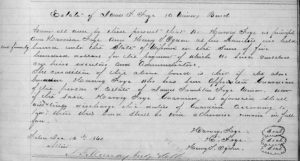
The men listed in that guardianship document are:
- Harvey FRYE, principal, and Harrison FRYE as his security. Who are they and how are they related to Frank? Harvey FRYE is a son of Jacob FRY/FRYE and Ellenor SPEAKS. Who are they and how are they related to William FRY? A son of Harvey FRYE is DeWitt Clinton FRY. DeWitt Clinton is the same name as my great-grandfather DeWitt Clinton HATFIELD, who was born three years earlier. Coincidence? DeWitt CLINTON (1769-1828) was a well-known national figure, so it’s hard to say.
- Harrison FRYE (also known as James Harrison FRY) is the brother of Harvey FRYE and is also a son of Jacob FRY/FRYE and Ellenor SPEAKS.
The second guardianship document, dated August 25, 1862, was for Franklin FRYE, so I’m assuming that Frank had dropped his first name James by that time.
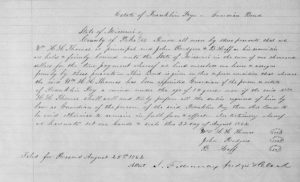
Why is there a second estate and guardianship document, for Franklin FRYE? There had to be a second guardianship because the guardian was now changed to William H. THOMAS. One other thing to note is that B. HAFF is listed as a security on the estate. James Harrison FRY was married to two different HAFF sisters. He first married Harriet HAFF and after she died he married her sister Mary. The HAFF family was related to Charlotte, the other Fry family researcher listed on the Pike County Genealogical Society website. So the HAFF surname also connects the families.
So if William FRY is Frank’s father, then the two men listed on the guardianship documents are uncles of Frank FRY.
Harrison and Harvey’s surnames are spelled FRY in 1860 and FRYE in 1862. The surname was spelled FRY and FRYE in various documents for many of the Pike County FRYS. (Various spellings for surnames is not uncommon.)
So where is Frank Fry in 1860? There is a Jas. F. FRY, age 10, in the Pike County 1860 census, living in the household of Mary J. WALKER, who was living next door to Harrison FRY and his wife Matilda. It is possible that Frank was indentured to Mary Walker, since Mary was a widow.
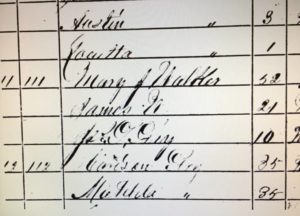
Assuming that William IS the father of Frank FRY, who then is William FRY? A Pike County probate file lists the heirs of Jacob FRY (1793 KY–1838 Pike), husband of Ellenor SPEAKS. They had eight sons: James, Hezekiah, William, Harvey, Harrison, Newton Y., Jacob J., and John, listed in the order of their birth.
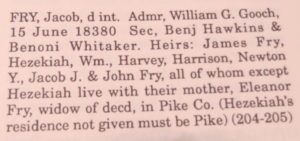
Sixth Generation
William Fry
William Fry was the 3rd child and 3rd son born to Jacob & Ellenor (Speaks) Frye/Fry. He was born in (probably Bourbon County) Kentucky between 1820 when his brother Hezekiah was born and Harvey, who was born in 1823. William died in Pike County, Missouri in Feb. 1850.
Closeup showing deed between William Fry and his father Jacob Fry on April 17, 1838.
Records show us that Burton Mullican/Mullikin was born in Shelby, Kentucky in about 1801, so it’s possible that these two families migrated together to Pike County.
Having examined every possible FRY couple in Pike County, Missouri, and despite the fact that I have not yet found a document that lists William FRY as the father of Frank FRY, I believe without a doubt that they are father and son.
Fifth Generation *
Jacob Frye
The book The History of Pike County, Missouri, page 642, lists Jacob FRYE as an “old settler” of Buffalo Township in Pike County, who came from Kentucky to Pike County in the early 1800s.
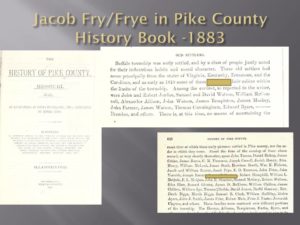
The book The History of Pike County, Missouri, in the section on Old Settlers: “Buffalo Township was early settled, and by a class of people justly noted for their industrious habits and moral character. These old settlers had come principally from the states of Virginia, Kentucky, Tennessee, and the Carolinas, and as early as 1810 some of them had built their cabins within the limits of the township. Among the earliest, as reported to the writer, were…[and] there is, at this time, no means of ascertaining the exact time at which these early pioneers settled in Pike County, nor the order in which they came. About the time of the coming…or shortly thereafter, came… Jacob Frye.”
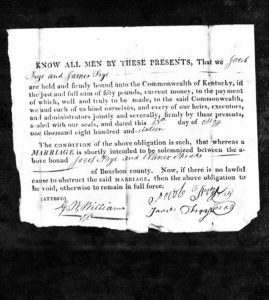
1830 Census. Pike Co MO – next to his sister-in-law, Elizabeth Fry, widow of his brother James Jacob Fry: 1m -5, 4m 5-10, 1m 10-15, 1m 30-40. 1f under 5. 1f 30-40
The widow of Jacob, in the 1850 census:
1850 Census. Buffalo Twp, Pike Co, MO, Hh 666
Eleanor Fry, 56, b. KY
Born in Missouri are:
Harvey, 27; Newton T., 20; Jacob J., 18; John S., 15
and living with them is Nancy J. McIntire, 14, b. KY
Eleanor (Speaks/Speake) Fry’s father was Hezekiah Speake. He was a fifer during the American Revolution and later became a soldier in the Continental Troops.
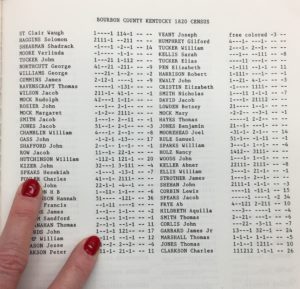
Fourth Generation*
James Fry
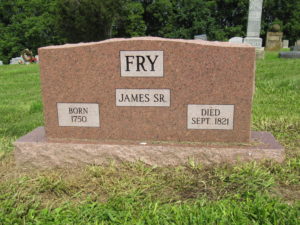
James Fry/Frye was born on 17 March 1759 in Frederick County, Virginia. He died in September 1821 at the age of 62 in Pike County, Missouri.
James moved with his parents to southwest Pennsylvania about 1769. He was a resident there when Washington County, Pa. was created.
James married Ann “Nancy” Spears in 1775 in what is now Bourbon County, Kentucky; however, in 1775 that area would have been Fincastle County, Virginia. The James Frye family, Jacob Speers family, and Henry Ewalt families moved to Bourbon County, Kentucky near the town of Paris.
James was on a tax list of Bourbon County in 1788. James Frye was listed in Jacob Kellar’s Will as his “trusted friend”. Jacob Kellar’s wife was Elizabeth Frye, brother of James Fry.
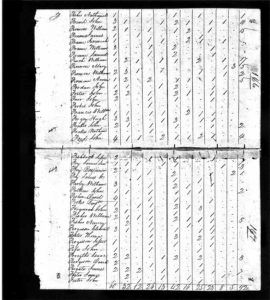
Another probate record from Pike County lists Jacob FRY as the son of James FRY (1759 VA–1821 Pike) and Ann “Nancy” SPEARS.
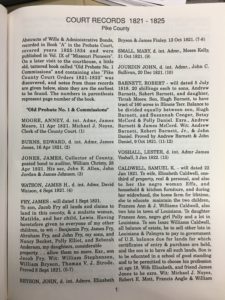
Fry, James – will dated 1 Sept 1821. To son, Jacob Fry all lands and claims to land in this county, and a Mulatto woman, Matilda, and her child, Lewis. Having heretofore given to everyone of my other children, to wit – Benjamin Fry, James Fry, Abraham Fry, and John Fry, my sons, and Nancy Becket, Polly Elliot, and Rebecah Anderson, my daughters, considerable property…allow them no more. Exr son Jacob Fry. Wit” William Stephenson, William Bryson, Thomas V. J. Strode, Proved 8 Sept 1821 (5-7)
James and Nancy Spears Frye, his sister Elizabeth and her 2nd husband Henry Ewalt, and Elizabeth Keller Spears, wife of Jacob Speers were all members of the Cooper’s Run Baptist Church, one of the earliest churches in Kentucky.
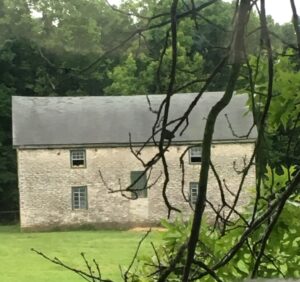
Some of the handwritten records of this church are in the Duncan Tavern DAR library in Paris, Bourbon Co KY. Nancy Frye [name listed as Anne] was baptized in Nov of 1791, James the following March. James Frye served as Trustee in 1792. By 1797, charges were brought against Bro. Fry for gambling and neglecting to attend public worship; he was excluded in March of 1801. Nancy continued to remain active in the church.
James appears to be listed in the 1790 “1st Census of KY” as James Frie of Bourbon Co.
On 30 Oct 1809, James had deeded 200 acres in Kentucky to son Abraham.
Family migration to Missouri began with James in 1817. However, James’ wife Nancy (Spears) did not move to Missouri but instead chose to say in Kentucky. We can only speculate but being in her late 50s, one cannot blame Nancy for not wanting to endure the “wilds” of Missouri to set up housekeeping anew in an unknown territory. It is believed that sons Benjamin, James Jr, Jacob, and possibly daughter Nancy, all grown & married, and their families, went to Missouri at the same time. All but Benjamin settled in what is today Pike County, apparently in a neighborhood with many settlers that had come from Kentucky. Benjamin went on farther north of the Salt River, in what is now Marion County near the Foremans and Birds.
Above: 1817 – Land owned by James Fry
Pike Co MO Deed Book A, p.173
19 Sep 1818 Land office at St. Louis, MO Territory. John Hymens of St. Charles Co on 13 Aug 1818 purchased the SW quarter of Section 12, in Twp 53, Range 2, which contained 160 acres and was sold to said John Hymens for $2.38 per acres or $380.80 on which has been paid $95.20, 1/4 part. He is to pay $95.20 on or before the 13th of Aug 1820, 1821, and 1822, to receive his patent. A. McNair, Register
15 Nov 1819 For value rec’d of James FRYE, I assign to him all my right and title to the within quarter Section. Witness my hand & seal on receipt of $275 by 1 Dec next.
Signed: John Hymens
15 Nov 1819 Acknowledged by John Hymens before Michael J. Noyes, Clerk of the Circuit Court
Recorded 23 Nov 1819 Michael J. Noyes, Clerk
Pike Co Deed Book, B, p.50-53
There are two successive deeds from William Tharp and Eleonore his wife to James Frye.
The first dated 31 Mar 1820 states that both parties were of the County of St. Louis in the Territory of Missouri. Frye paid $1040 for 230 3/4 acres, to be taken out of a tract of 800 arpens lying on the Salt River in Pike Co, beginning the SW corner according to the original Spanish Survey, the northern of three tracts purchased of Charles Formon DeLauriere. Wit: P. W. Ross & Thos. Sappington. William & Elenore appeared before a Justice of the Peace and acknowledged the deed, Eleonore being privately examined. Thomas Sappington, J.P. Attest: Michael J. Noyes, Clerk. Recorded 20 May 1820.
The second deed made on the same day. Again the consideration was $1040. The tract of land was described as 320 acres “being the same I purchased of said Frye” as I received it, on the South fork of the River De Peres in the County of St Louis, Sec 26, T45 N, Range 5 East.. Said Frye paying the Government for the premption and additional improvements made by said Tharp. The above transaction arises out of an exchange of one tract of land for another. There follows an agreement, apparently guaranteeing rights in this tract, an unconfirmed Spanish claim, as Frye will be holding it under Tharp’s title. Same witnesses and Justice; recorded 22 May 1820.
James Fry also attempted to patent a tract through the federal Land Office, but apparently died before the patent was perfected, and it may have been years before heirs actually received the land. Dated 30 Mar 1820 in the index but the copy of the patent refers to the 50th year of Independence which would be 1826 instead, Pike Co MO, Cash Sale; 160 acres, T 53N, R 2W, the SW 1/4 of Section 12. Issued to the legal heirs and representatives of James Fry, dec’d, Assignee of John Hymers. Then there is a Certificate #982, Dated 15 September 1975 – that states:
Know Ye, That the legal Heirs and Representatives of James Fry dec. Assignee of John Hymers having deposited in the General Land Office, a Certificate of the Register of the Land Office at St. Louis in Missouri whereby it appears that full payment has been made ….
There is Granted, by the United States, unto the said Heirs and Representatives and to their heirs the quarter lot or section of Land described.
…This patent is granted as and for a patent intended to have been granted and issued on Mar 30, 1826, but the issuance of which is not sufficiently evidenced by the records of the Bureau of Land Management. Patent number: 61-76-0025.
The original patent also stamped with this number and the date 15 Sep 1975.
My Note: I wonder if this patent had been misfiled as 1820 instead of 1826 and that’s why not even the BLM could find it….or was it simply never sent to the heirs. it’s obvious it was made out when John Quincy Adams was President. Since he served from 1825-29 – it’s also obvious that the patent was dated 1826, not 1820.
Will in Pike County, MO. 1 Sep 1821. Proved 8 Sep 1821. Leaves son Jacob all lands in this county. Son Jacob gets mulatto woman Matilda and her child Lewis and other real & personal property and asks him to pay debts and funeral expense. Other children have received their share: Benjamin, James, Abraham, John, Nancy Beckett, Sally Elliot, Rebecca Anderson. Executor: son Jacob. No wife mentioned. [No Sally or Sarah listed as a daughter. Sally Elliot may be someone else. She may also have been the daughter seen elsewhere as Mary.]
According to the Pike County Court Records James Fry had a child named Lucas with a “mulatto woman named Matilda” after his wife Nancy decided not to migrate with her husband James Fry to Missouri.
I have been contacted by a descendant of Lucas. According to the woman who contacted me, she has DNA matches to other Frys in this family.
http://www.pcgenweb.com/pcgs/misc/probate.htm
James Fry SR
(Note from submitter: This is the father of James Fry, Jr. James Fry SR was married to Nancy Spears. He died in 1821 in Pike Co, MO, and according to my father who walked the Old Buffalo Cemetery (Jordan-Buffalo), both James Fry, Sr and James Fry, Jr. are buried there, but the markers are gone.) The Fry family had the above headstone placed in the Jordan-Buffalo Cemetery.
Pike Co, MO Old Probate Bk #1 & Commissons pg 5-7 James Fry will 1 Sept 1821 to son Jacob Fry, other children Benjamin, James, Abraham, John, Nancy Becket, Polly Elliot & Rebecah Anderson, proved 8 Sept 1821.
The following found in an Ancestry Family Tree. The webpage notated is no longer available.
The following was obtained from the Internet August 2006 (http://www.shawhan.com/Notes/frye.html)
(1) Name: James Frye (Frey)—————————————————————
Birth: circa 1750 Frederick County, Virginia
Death: after September 1, 1821 Age: 71
Father: Abraham Frye (-1807)
Mother: Agnes Ann Young
Misc. Notes
Daniel Boone and James Fry(e)
While the encounters between the Boones and John, Jacob and William Fry(e) are a matter of historical record, a connection with James is only circumstantial at best. While it is quite possible that James may have met Boone face to face, there is slim chance of ever proving it at this point. Despite that lack of physical evidence, Boone undoubtedly had a great impact on him.
James Fry(e) was born in Frederick County, Virginia sometime around 1750, and moved with his parents, Abraham and Agnes-Ann (Young) to southwestern Pennsylvania somewhere between 1769 and 1772 (see Journal, Aug. 1993). He was a resident there when Washington County was created in 1781, having paid taxes that year on 200 acres, two horses, four cattle and four sheep (PA Archives Series 3, V22, p 731). He was apparently living near the farms of his parents and two brothers in Fallowfield Township. He was married to Nancy Spears, daughter of Henry and Regina (Froman) Spears, and although the date is not certain, it must have been just prior to 1775.
It might be noted that Henry Spears and Paul Froman migrated to western Pennsylvania from Frederick County, Virginia as well, and it is quite possible that they and the Kellar, Crist and Frye families may have migrated together.
Nancy was born apparently in Virginia on March 17, 1759 (Spear-Fry Cemetery, Bourbon County, Kentucky).
In 1784, immediately following the end of the Revolutionary War, James served as a Private 4th Class in the Washington County, Pennsylvania Militia in an Indian Spy Company under Lt. Thomas Crook. Two years later, James was involved in a controversy with the U.S. government, and on April 27, his home and improvements were burned on land settled contrary to regulations set forth by the U. S. Congress. He had, at this point, been located some thirty miles downstream (southwest) of Pittsburgh on the Virginia side of the Ohio River adjacent to the present state of Ohio. This was probably in what is now Ohio County, West Virginia, and although the specifics are not known, it is speculated that he may have built a cabin or shelter across the river, perhaps grazing cattle, thus defying a treaty with the Indians. Also involved in the controversy, was John Kellar.
James Fry(e)’s arrival into central Kentucky is thought to have been sometime between mid-1787 and early 1788. At any rate, he is not on the list of taxpayers for 1787, but is the following year. This is also true of the party that appears to have migrated with him. In all probability, James and Nancy migrated to Kentucky along with Henry and Elizabeth Ewalt, and Jacob and Elizabeth Spears. (Elizabeth Frye Kellar Ewalt was a sister to James, and Jacob Spears was a brother of Nancy, James’ wife. Thus these three families were closely related.)
If they arrived late in the summer of 1787, they may easily have missed the tax assessments for that year, for the Virginia legislature had passed a law in October of 1786 decreeing that tax collecting operations in the Kentucky counties were to begin on March 10 of the following year. Although greatly scattered out over a large area, with such a small number of residents then living in Bourbon County, it would seem reasonable that those in the Fry(e) party may have arrived late enough that year to have missed the taxation process for 1787. Furthermore, various legal records, including tax lists, for Washington County Pennsylvania, give witness that Jacob Spears and Henry Ewalt were in Washington County in 1786, but show no evidence of their presence the following year. In addition, James Jr. is said to have been born in Kentucky in 1787. This information comes from the research of Robert Excell Fry of Pike County, Missouri, who did a very scholarly research through court house records etc., back in the 1920s. He is a descendant of James Fry Jr. Unfortunately, his source is at this point. Nevertheless, James Jr.’s brother Abraham was born there the following May (1788).
In an article written by Josephine H. Ewalt, the following notation is written concerning her great-great- grandfather, Henry Ewalt:
“When he was mustered out (from service during the Revolution) and returned to Western Pennsylvania, he found that his neighbor had been killed in the War and had left a young son and widow, she (being) Elizabeth Frye Keller. In 1782, Henry married the young widow. Two little Ewalt girls and an Ewalt boy came along in due time. And now Henry had to take a look at the economic future.”
He had brothers older than he. The English primogeniture laws still prevailed in the Colonies during this pre- Constitutional period. Henry was most certainly not going to inherit the Bedford County land. So he decided to try his fortunes in the newly opened Kentucky County of Virginia. A flat boat down the Allegheny and into the Ohio to the landing place at Limestone (now Maysville) carried Henry and his family to the land of opportunity. The step-son, Abraham Keller. thus came to Kentucky and was the progenitor of many Kellers in this county.” (From “Henry Ewalt and the House He Built”).
Indeed, the party must have followed the Old Buffalo Trail, for it crosses Cooper’s Run almost immediately behind the tract the Fry(e)s were to settle on. There to the north side of the Old Buffalo Trail, the Spears, Fry(e)s and Ewalts were to settle on adjacent tracts almost within shouting distance of each other. To the south side had been Cooper’s Fort, built a dozen years before by John Cooper who was the first in the area to clear land and raise a corn crop, from which he sold seed to migrating settlers until Indians killed him. In between Cooper’s Fort and the newcomer’s tracts, ran Cooper’s Run Creek.
The decade of the 1780s had seen numerous incidents between Indians and the few who dared to encroach upon their hunting grounds there in Bourbon County. These reached a peak in 1788 with the Shanks Massacre along Cooper’s Run, a very short distance from where the Spears, Fry(e)s, and Ewalts had chosen to settle.
“A small band of Indians had attacked the frontier house, and set it aflame to force out the victims, mainly the widow Shanks and her children. They terrorized the family, killing five, and kidnapping a girl whom they later scalped. The Indians stole some of the horses, and retreated. Neighbors pursued them and killed two of the Indians)” (Everman, p 4).
It is likely that James Fry(e), Jacob Spears and Henry Ewalt were among the neighbors that pursued the Indians. Everman mentions that Jacob Spears was one of the prominent officers of the militia in those early years (p 16). As for James, he is listed as a lieutenant in the Bourbon County Militia as of July 29, 1789, and by November 5th of the following year, has risen to the rank of captain.
Although the Indian threat abated, settlers remained cautious, as Indians continued to raid along the overland routes.**John Keller stated in a deposition dated 1806 that he came in the year 1776 with a party including Patrick Jordan, Reuben Wats (Waits), James Thompson, John Irvin and others. He made an entry for his brother, Jacob Keller. He stated that Abraham Keller was the son of Jacob Keller, deceased” (Ardery, p 12).
This Jacob Keller (Kellar) is Elizabeth Frye’s first husband.
For the new arrivals, this location may have made more sense in 1787/88 than it perhaps would a decade later. In 1787, there was no town of Paris. Indeed, one of the first structures there was Duncan Tavern, built in 1788. Yet a short distance from our settlers at Cooper’s Run was the Johnson Inn, located strategically along the Buffalo Trail. Built also in the 1780s, it was a favorite stopping place for travelers in their journey between Limestone and Lexington. While the area was chosen as the county seat for the newly formed Bourbon County (1786), court was held at first in the homes of prominent settlers (John Kiser’s home on Cooper’s Run was chosen that year). It must have seemed in 1787/88 that a community might well spring up near where they had settled. This would change with the selection in 1789 of Hopewell (Paris) by the Virginia legislature to be the county seat (see Jacob Fry).
Our party of settlers undoubtedly lived in rude shelters at first, as attested to by Josephine Ewalt:
“In 1788, Henry bought 200 acres of land North of Cooper’s Run for the amazing sum of 110 pounds sterling (about $1.50 an acre). On that land, he built first a small temporary house, while he and his neighbors cleared the land of the thick virgin forest so that they could plant crops. They finally built the ‘big house,’ the two story frame front part of today’s structure with stone chimneys at each end.”
While there is some controversy as to exactly when the structure was built, it is estimated that construction occurred during the early to mid-1790s. It still stands today at what is appropriately known as Ewalt’s Crossroads. Of it, Everman states, “This Revolutionary War veteran possessed one of the most elegant homes with paneled walls (ash and walnut) and molded ceilings, and decorated with exquisite hand carvings” (p 19).
Perhaps during this same time, Jacob Spears began construction on his house, “Stone Castle”. It is featured in the book, Historic Architecture of Bourbon County, Kentucky, which states,
“The house was built for Jacob Spears shortly after his arrival in Bourbon County in 1787 or 1788. It has the characteristics of the work of builder John Metcalfe, who had traveled to Kentucky from Virginia with a group under the guidance of Simon Kenton in the same year” (Langsam, p 38).
Whether the Spears, Fry(e) and Ewalt party came in from Limestone with this group may never be known. Yet it is interesting that attempts were made at such an early point to establish the trappings of civilization, though the conditions upon their arrival were far from that.
While the Spears home was perhaps, chiefly the work of John Metcalfe, undoubtedly Jacob’s sons and slaves helped with the labor. It features a spiral staircase and cherry paneling in the front room, and is considered a county historical landmark today. Jacob Spears was to make his money in the distillery business, one of 128 listed in the Bourbon County Census of 1810.
Across the lane on the Fry(e) side, the Spears built a warehouse for their distillery operation, and this also still stands. While James undoubtedly dabbled in the same business at times, he was certainly never to become the successful entrepreneur that the Spears were. It is likely that much of his labor was put into farming, although Langsam tells of James’ son Abraham,
“Fry was an early settler in this area, and operated a distillery on his farm. His son, I. N. (Isaac Newton) Fry, continued to occupy the farm, and his name appeared on both the 1861 and 1877 maps” (p 39).
As for James Fry(e), he was to purchase his 200 acres from the Jacob Spears tract on July 20, 1790. Unfortunately, his home no longer survives as do the other two. Undoubtedly their first structure was also a crude cabin, but as was the case with the others, this was replaced by a more permanent home. However, unlike the others, we have no surviving clues as to when it may have been built. The fact that it was brick, has led some to question the possibility of an early date. Yet Ardery notes that, “More permanent buildings of brick began to replace those of log by 1796” (p 7).
This may come as a surprise, but Langsam says much the same.
Since James didn’t seem to prosper on the scale of his neighbors, we may surmise that his was probably the last of the three to be built. Nor did it share the elegance of the others. Even the fact that the Fry(e) homestead was called “Musk Rat Valley” fails to compare with the more sophisticated “Stone Castle” of the Spears estate. This is the same estate that James willed to his son Abraham in September of 1809. The fact is that other than in the 1810 census, we hear very little about James during the next decade, although we know that Nancy continued to live there at the homestead with her son until her death in 1839 (Mar. 25).
James may have been in and out of the county during this, period as he was in February of 1804 when he and Jacob Spears brought litigation against one Abner Reeves over a debt (Common Pleas Ct., Knox Co. Indiana Territory Minutes 1800-1806, p 171).
He probably set up the original distillery on his farm – the one his son Abraham operated (Langsam).
Perhaps this was the reason for his less than settled life style. Although we have no record as to how much he produced, or how he disposed of his stock, his nephew Solomon Spears (Jacob’s son) floated barrels by boat down to New Orleans, and then walked back home up the Natchez Trace, making the trip 13 times during that early period (Everman, p 37).
Although James’ age may have prevented a trip of that magnitude (to New Orleans), his business dealings may still explain his apparent absences. He certainly seems to have possessed a restless spirit. Ultimately however, it may have been Daniel Boone that ignited his desire to move on into Missouri.
In 1799 Boone had become discouraged enough with his debts and failed business dealings, that he left for Missouri, although he is said to have given the following reason officially, “Too many people. Too crowded! Too crowded! I want more elbow-room” (Steele, p 393).
Nearing his 65th birthday in 1799, Boone set out for the Femme Osage District of Spanish-owned Missouri. As Boone made the trip on foot, crowds gathered all along the way to see this famous hunter. Within a year, Spanish officials appointed him magistrate of the district. whose duty was to keep law and order, and occasionally judge law cases. Though possessing no legal experience, he, nevertheless, gained a reputation for wisdom and fairness. When the territory passed from Spanish into French and then American hands in 1803, Boone again lost most of his land claims, since they had been registered with Spanish officials. Finally, in 1814, a year after the death of his wife Rebecca, a small portion of his claims were restored to him by the U. S. Congress in appreciation for his role in the opening of these two frontiers. ‘As a result, Boone became financially able to return in 1817 to Kentucky to pay off debts. Some of the earliest records in Bourbon County concern suits against Boone and Simon Kenton for not “paying their debts promptly”. Boone was, in fact, quite conscientious despite the losses he had repeatedly suffered regarding land claims.
Having said he would never return to Kentucky, Boone mellowed in his latter years. Like a returning hero, wherever he went, people turned out to get a glimpse of him, as “…aging companions came to see him and brought their children and grandchildren so that in years to come they could say that they had once shaken the hand of Daniel Boone” (The Long Hunter; Elliott, p 199).
Boone reportedly reached home with but 50¢ left.
Could it be that James was one of those that sought out Boone’s attention? Did he listen to Boone’s accounts of Missouri? Perhaps! Perhaps not! Yet sometime in his late 60s, James began planning for his final adventure – into Missouri. Yet even more remarkable, Boone returned home that year to prepare for his final hunting trip – this time west to Kansas and the Dakotas, following the Platte River to the Rockies, and spending the winter season trapping in the Yellowstone region. But what made this so remarkable was that Boone was well past his eightieth birthday. Back in Missouri, he was sought out in 1819 by the American artist Chester Harding who is thought to have made the only portrait of Boone painted from life. And finally, on September 26, 1820 at the age of 86, Boone died while visiting the home of his son Nathan.
According to research done by Robert Excell Fry, James and some of his family came to Pike County Missouri in the spring of 1819. He noted that James Jr. was in Kentucky early in 1819 but not in 1820. In addition, of James Sr.’s other children, Jacob, Benjamin, and possibly Nancy also went out to Missouri. However, there is no evidence that their mother Nancy ever went west. This has left family researchers with some glaring questions. Nancy would have been 60 at the time, but still younger than her husband. When James willed his farm to his son Abraham, Nancy continued to live there with him, and was there when she was named on a summons on October 4, 1820 that she was an heir to part of the estate of Solomon Spears, deceased. In fact, she died there twenty years later on March 25, 1839, and was buried in the Spears-Fry Cemetery behind the Jacob Spears mansion in Bourbon County. Why did she not join her husband in Missouri?
He appears to have been in Missouri for possibly two and a half years before his death in Pike County, where he made out and recorded his last will on September 1, 1821. In this he gave his son Jacob “all my lands in this county… ,” (as well as) “my mulatto woman, named Matilda and her child named Lewis, together with all my other estate both real and personal….”
He acknowledged that his other children had already received their inheritance and would receive no more. Had James and Nancy been estranged (receipts do exist that show she did send money to Missouri territory), or did she plan to join him after living quarters had been adequately prepared? To this and other questions we may never have an answer. Yet James, like Boone, had lost a considerable sum of money in a land sale deal, and had few personal effects at the time of his death. (See Journal, July 1992.)
Whether James ever personally met Boone we’ll probably never know. Yet Boone’s influence on the restless spirit of James Fry(e) certainly seems strong to say the least. (A great deal more can be said of James Fry(e) -a fascinating man we plan to feature again.)
SELECTED BIBLIOGRAPHY:”All Who Are Not Cowards Follow Me!” Pamphlet Published by Kentucky Dept. of Parks, Frankfurt, KY, 1993.Andery, Mrs. William Breckenridge.
Historical Scrapbook. Bourbon County, KY: Produced by Bourbon Co. Sesquicentennial Commission, Inc. 1939.
Blanton, Alice Rogers Clay. Historical Map of Bourbon County, KY. 1934.
Bourbon County Taxpayers, 1787-1799. Miami Beach, FL: T. L .C. Genealogy, 1992.
Brookes-Smith, Joan E. Master Index, Virginia Surveys and Grants 1774-1791. Frankfurt, KY: Kentucky–Historical Society, 1976.
Bryan, William S. and Rose, Robert. Pioneer Families of Missouri. Baltimore: Genealogical Publishing Co., Inc., 1984.
Carpenter, Stephen J. “Roster of ‘First Kentucky Ancestors’ – Adam Carpenter” Kentucky Ancestors. Kentucky Historical Society, Vol. 24 #2, 1988: p 121.
Cavan, Seamus. Daniel Boone and the Opening of the Ohio Country. New York: Chelsea House-Publishers, 1991.
Clift, G. Glenn. The History of Maysville and Mason County Vol. I. Lexington, KY: Transylvania Printing Co., 1936.
Cook, Michael L. Fayette County Historical Records Vol. I. Evansville, IN: Cook Publications, 1985.
Cook, Michael L. Fincastle and Kentucky Counties, Virginia – Kentucky Records and History Vol. I. Evansville, IN: Cook Publications, 1987.
Cook, Michael L. Kentucky Pioneer Genealogy and Records Vol. 11 (1). Hartford, Ky: Cook and McDowell Pub., Jan. 1980. p 18.
Elliott, Lawrence. The Long Hunter. A New Life of Daniel Boone. New York: Readers Digest Press, 1976.
Everman, H. E. The History of Bourbon County 1785 – 1865. Paris, KY: Bourbon Press, 1977.
Ewalt, Josephine Hedges. “Henry Ewalt and the House He Built.” Bourbon County KY: An unpublished work, 1986.
Fackler, Colvin M. Early Days In Danville. Louisville: The Standard Printing Co., 1941.
Fothergill, Augusta B. and Nangle, John M. Virginia Taxpayers 1782-1787. Self Published, 1940.
Frye, Archie S. Personal conversations. Georgetown, KY, 1995-96.
Gilbert, Bil. God Gave Us This Country. New York: Atheneum, 1989.
Harding, Margery H. George Rogers Clark and His Men – Military Records 1778 -1784. Frankfurt: The Kentucky Historical Society, 1981.
Hughes, Nicky. “Battle of Blue Licks.” The Kentucky Encyclopedia. Ed. John Kleber. Lexington, KY: University Press of Kentucky, 1992.
Jillson, Willard Rouse. The Kentucky Land Grants Vol I. Baltimore: Genealogical Publishing Co., Inc., 1971.
Langsam, Walter E. and Johnson, William G. Historic Architecture of Bourbon County, Kentucky. Bourbon County: The Kentucky Heritage Council, 1985.
Nickell, Joseph. “Daniel Boone.” The Kentucky Encyclopedia. Ed. John Kleber. Lexington, KY: University Press of Kentucky, 1992.
Norris, J. E. History of the Lower Shenandoah Valley. Chicago, IL: A. Warner and Co., Publishers, 1890.
Pennsylvania Archives. Series 3, Vol. 22. Ed. Egle, William Henry. Harrisburg, PA: William Stanley Ray – State Printer, 1897.
Rockenfield, Sarah Ridge. Our Boone Families, Daniel Boone’s Kinfolks. Evansville, IN: Whipporwill Publications, 1987.
Rone, Sr., Wendell H. An Historical Atlas of Kentucky and her Counties. Mayfield, KY: Mayfield Printing Co., 1965.
Selby, John E. The Revolution in Virginia 1775-1783. Williamsburg, VA: The Colonial Williamsburg Foundation, 1988.
Spraker, Hazel Atterbury. The Boone Family. Baltimore: Genealogical Publishing Co., 1982.
Steele, William 0. “Daniel Boone.” World Book Encyclopedia, Vol. 2 Chicago, IL: Scott Fetzer Co., 1976.
Thwaites, R. G. Kellogg, L. P. “Dunmore’s War (1774).” Dictionary of American History. New York: Charles Scribner’s Sons, 1940.
Zumwalt, Solomon. “Biography of Adam Zumwalt.” Missouri Historical Review Ed. Brownlee, Richard S. Columbia,, MO., April, 1954. pp 252-257+.”7. Rebecca Fry was born June 6, 1784, died October 3, 1819, married in 1802 Robert Gilmore Anderson, Sr., born April 15, 1782, died May 21, 1841.They had a daughter, Nancy Anderson, born November 8, 1805, in Bourbon County, Kentucky, died December 11, 1887, in Dallas County, Texas, buried in Wheatland Cemetery, Dallas County, Texas. She married John Penn.
JAMES FRYE and ANN “NANCY” SPEARS were married before 1775.63 ANN “NANCY” SPEARS2,29, daughter of HENRY SPEERS and REGINA FROMAN, was born on 17 March 1759.5,11,29 She died on 25 March 1839 at the age of 80 in Bourbon County, Kentucky.5,29
Nancy was baptized in the Cooper’s Run Baptist Church in November, 1791. She applied for a letter of dismissal on 11 April 1818. Elizabeth Spears, wife of Nancy’s brother Jacob, withdrew from the church the same time.
Mr. Adams has given a birthplace as Winchester, in Frederick Co VA. If the family came from Germany to Pennsylvania in 1772, just before the death of Henry’s father, then Nancy was surely born in Germany. However, this appears to be an error in the date of their arrival.
Nancy Fry was the defendant in a civil court litigation between Oct of 1796 and Dec of 1797. Hannah Phillips had been degraded and damnified in good name because Nancy had proclaimed that Hannah had been meeting someone by the name of Cooper at the spring to commit adultery. On Dec 30, 1797, a jury decided that James Fry should pay Elijah Phillips [Hannah’s husband] £20 in damages. A costly lesson.
Nancy apparently did not go to Missouri with her husband. She might have gone and then returned. However, he did not even mention her in his will. She was named in a summons in 1820 in Bourbon County as an heir to estate of Solomon Speers, probably her brother. She is thought to have remained with her son Abraham who had inherited his father’s property in Kentucky. She was buried in the Speers-Frye Cemetery in Bourbon County KY.
1830 Census. Bourbon Co KY
Abe Fry: 2m 5-10, 2m 10-15, 1m 20-30, 1m 40-50. 2f 15-20, 1f 30-40, 1f 70-80 [probably his mother]
James Frye and Ann “Nancy” Spears had the following children: Benjamin Fry, Nancy, Frye, John Frye, Rebecca Frye, James Frye Jr., Abraham Frye, Elizabeth Frye, Jacob Frye, and Mary “Sally” Frye.
James Fry moved to Pike County, Missouri in about April 1819.
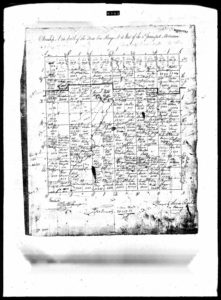
James Fry’s will dated 1 September 1821 stated:
In the book, section Court Records 1821-1825, Pike County, and on page 1 it has: James Fry – will dated 1 Sept. 1821. “To son Jacob Fry all lands and claims to land in this county, & a mulatto woman, Matilda, and her child, Lewis. Having theretofore given to everyone of my other children, to wit: Benjamin Fry, James Fry, Abraham Fry, and John Fry, my sons, and Nancy Becket, Polly Elliot, and Rebecah Anderson, my daughters, considerable property…allow them no more.” Exr. son Jacob Fry… Proved 8 Sept 1821. (5-7)”
Third Generation
Abraham Frye
(1722-1807)
Below is Biography of Benjamin Frey: by Kay Haden* https://sites.rootsweb.com/~katy/fry/index.html, with some corrections.
ABRAHAM FRYE was born in 1722 in Perkiomen, Philadelphia County, Pennsylvania.8 He served in the military in 1776 at 5th PA Regt of Foot; Capt William Oldham’s Company, Washington Co Pennsylvania in the Revolutionary War. He died on 1 February 1807 at the age of 85 in Fallowfield Twp, Washington County, Pennsylvania.8
In one place, Hank Adams had this marriage date as 1758, but that’s after birth dates of several of the children – in another he had c 1749 which seems more reasonable. Donald Kearney, another Fry family historian, believed Abraham might have married before leaving Pennsylvania.
Abraham was living on the 200 acres on Cedar Creek apparently deeded to him by his father by 1751, when Benjamin gave the remainder of his homestead to his son Joseph, because Joseph’s land was bounded by Abraham’s plantation. No direct record has been found.
19 Apr 1765, land grant to Abraham Fry at the request of William Thomas to whom the land was assigned by John Thomas in the presence of Jos/Jno Hite. The Thomases were brothers, sons of Ellis Thomas who was killed by Indians in 1763. On 13 Apr 1751, the petition to grant 400 acres to James Stuart was recorded. Said to be 400 acres of ungranted land adjoining Ellis Thomas on the head branches of Hoggs [Hogue] Creek. The land was surveyed the following week but contained only 200 acres. James Stuart was an orphan and his guardians requested a more desirable tract of land for him. Ellis Thomas then offered to take the land and add to his own holdings. 28 Jan of 1764 the heirs of Ellis Thomas and James Stuart appeared at the proprietor’s office and agreed that a deed should issue to John Thomas, eldest son of Ellis Thomas, having purchased it from Stuart. In 1765, John Thomas transferred his rights in the land to his brother William. Subsequently this tract became Abraham Fry’s. According to Donald Kearney, this 200 acres was later sold to Henry Secrist.
Researcher Donald Kearney relates a reminiscent story regarding Abraham Frye and an Indian incident. In 1768, William White who lived on Cedar Creek, and another man, shot and killed two Indians in the woods. This was after the cessation of hostilities and White and his companion were jailed in Winchester. Capt Abraham Frye [a complimentary rank?] raised a party of perhaps 50-60 volunteers who proceeded to Winchester and freed the two men, apparently with the blessings of most of the community. Perhaps this occurrence was part of reason Abraham Fry decided to leave Cedar Creek the next year.
Frey Family Association Journal, Spring 2011, p.36-37.
Family lived in Frederick County, VA – some of children born there. Moved to southwest Pennsylvania about 1769 – Washington County was created in 1781. Other families moving from VA to PA included Henry Speers and Jacob Froman, Paul Froman Sr., and Paul Froman Jr., the Kellars, and the Crists, as well as Abraham’s brothers William, Samuel, and Benjamin.
Tracing the History of the Descendants of Paul Froman Sr. and Elizabeth Hite: https://drive.google.com/file/d/1kV8IT9kjGMbzvE4LyP69adw9LNAZ_Tsk/view%MCEPASTEBIN%
Incorrect DAR Lineage: In 1778 Abraham Fry was a private in Capt. Charles Maclay’s Co., 1st Battalion, Cumberland County PA militia. This is a different man who continued living in Cumberland County.
Abraham served in the 5th PA Regt of Foot, commanded by Col. Francis Johnston; he served in Capt William Oldham’s Company from Washington Co PA. The service can be found in the Pennsylvania Archives.
FREDERICK FINDINGS: Vol. 9, #1, Spring 1996 , p.13
At a Court held for Frederick County [VA] on Tuesday 8th August 1749. The Appraisment of Estate of James Young Deceased was presented into Court by Jane Young & Abraham Frey, Executors & admitted to record.
Northern Neck Grants M, p.344. 19 Apr 1765. 200 acres granted Abraham Fry on head branches of Hogg’s Creek, Frederick County.
Virginia Land Grant: To Abraham Fry, 31 Dec 1783 in Jefferson Co KY; 500 acres on Beech fork, branch of Salt River adjacent Jacob Froman. [Grant in Library of VA Cardfile on line but link to document is incorrect and I could not get a copy.] This is the land Joseph Foreman held in trust to settle dispute over said land and mentioned in Abraham’s Will. The land was to be sold and proceeds divided equally among the daughters.
The same grant from Filson:
Grantee: Fry, Abraham
Acres: 500
Book: 2
Survey Date: 7-20-1783
County: Jefferson
WaterCourse: Beech Fk
Reference: THE KENTUCKY LAND GRANTS
Volume 1
Part 1
CHAPTER II VIRGINIA GRANTS (1782-1792)
THE COUNTIES OF KENTUCKY
page 52 More Info: Grantee: Fry, Abraham
Acres: 500
Book: 2
Page: 35
Date Survey: 7-20-1783
County: Jefferson
Watercourse: Beech Fk
Washington County, Pennsylvania
Will Books 1 & 2 1781-1814
LDS #0863624
Will Book 2, p.98
Will of Abraham Frye
Be it remembered that on this fourth day of April in the year of our Lord one thousand eight hundred and one I Abraham Frye Senior of Fallowfield township Washington County and state of Pennsylvania being in a good state of health and of sound disposing mind and memory: yet calling to mind the uncertainty of time do make and ordain this my last will and Testament, touching the disposal of my temporal estate hereby revoking all other will or wills by me heretofore made and this only to be taken for my last will and testament and none other. Imprimis. I will that all my just debts [if any should appear tho I know of none] be fully paid, and all such legacies as I may hereafter mention in this Instrument of writing – Item I have already given unto
My son Benjamin Frye and to his heirs and assigns four hundred acres of land for which I have made him a deed lying on Lost River a branch of Capon in Virginia. I have also given my said son Benjamin a good horse and saddle with other articles not necessary here to be enumerated which I consider his full share and dividend of my estate both real personal or mixed. Item: I have already given unto my son James and to his heirs and assigns four hundred and fifty acres of land lying in Washington County where Samuel Moody now dwells which my said son James Frye sold to John West and received the full amount thereof. I also gave my son James a good horse and saddle and other articles not necessary here to be within stated which I consider to be his full share and dividend of my estate both real personal or mixed – Item: I give and bequeath unto my son Abraham Frye and to his heirs and assigns two tracts of land one of which is the place where I now dwell containing one hundred and seventy eight acres and allowance of six pct. Patented the twenty ninth day of August one thousand seven hundred and eighty five the other adjoining the last mentioned tract containing one hundred and eighty three and three Fourth acres and allowance of six pct. Int. Subject to the maintainance of his mother which he shall do in a decent manner at least to comply with the following particulars relative to her maintainance to wit, I will that he shall give her full possession of that part of the dwelling house which she and myself now reside in and to find her in a plenty of provision suitable to make a person of her age a comfortable living and also to provide for his sd Mother as much dressed flax as she shall see cause to make use of for her own particular use and to furnish her with a good horse and saddle and bridle to ride at any time when she may have use for the same — Item I give and bequeath unto my well beloved wife Agness one Negro boy [who is free at the age of twenty eight years] during her natural life and at her decease I will that he the said boy named Derry shall belong to my son Abraham and to his heirs until he the said Derry shall be twenty eight years old at which time he is free.
And furthermore I will that my beloved wife shall have all my household funrature at her own disposal – Item I will that all my personal estate (exclusive of what is above mentioned) money which I may have on hand or due on bond note or book acct may be equally divided amongst my daughters to wit my daughter Margaret and to her heirs one share, to my daughter Christina and to her heirs one share, also to my daughter Elizabeth and to her heirs one share also to my daughter Mary and to her heirs one share also to my daughter Rebeccah and to her heirs one share, also to my daughter Catherine and to her heirs one share, also to my daughter Nancy and to her heirs one share. And whereof I have five hundred acres of land lying in Kentucky on the beach fork a branch of ?Salt River I have lately conveyed to Joseph Foreman in trust in order to give him full power to commence a law suit and settle a dispute which a man in that state pretends to hold about said land. I also will that if the said five hundred acres of land should be gained by the said Joseph Foreman at law, that it be sold by my executors and be equally divided between all of the above named daughters And lastly I do hereby nominate and appoint my son Abraham my son in law Noah Speers to be my Executors to execute this my last will and Testament according to the true intent and meaning thereof – as witness my hand and seal the day and year first above written – Abraham Frye
Sealed signed and acknowledge in the presence of us Samuel Frye senior – William Crawford – Benjamin Hough – Samuel Frye Junior
Washington County
Be it remembered that on the twenty sixth day of February in the year of our Lord one thousand eight hundred and seven, before me, Isaac Kerr, Register for the Probate of Wills and granting Letters of Administration, in and for the county aforesaid came William Crawford and Samuel Frye Junior two of the subscribing witnesses to the within last Will and Testament of Abraham Frye Senior late of Washington County, deceased, and being sworn as the law directs, depose and say, that they were personally present, and did see the Testator therein named sign and seal this Will and that they heart him publish pronounce and declare the same to be his last Will and Testament, That at the time of his so doing, he was to the best of their apprehensions of sound and disposing mind memory and Understanding, that they respectively subscribed their names as Witnesses to the Will in the presence and at the request of the Testator and in the presence of each other, and that they also saw Samuel Frye Senior and Benjamin Hough the other witnesses, signed to this Will Subscribe their names thereto as such. William Crawford, Samuel Frye Junior
Sworn to and Subscribed before me – Isaac Kerr, Register
February 26th 1807. Letters Testamentary with copy of Will annexed, issued to Abraham Frye and Noah Speers, Executors herein named, and on the same day, the said Abraham & Noah were Sworn. Isaac Kerr, Register
Registered 26th February 1807.
ABRAHAM FRYE and AGNES ANN YOUNG were married in 1749.32 AGNES ANN YOUNG, daughter of JAMES YOUNG, was born in 1730.33 She died in 1809 at the age of 79.33
Abraham Frye and Agnes Young Fry has the following children: Benjamin Frye, Christina Frye, Margaret Frye, Elizabeth Frye, James Frye, Mary Frye, Abraham Frye Jr., Rebecca Frye, Catharina Frye, and Nancy Virginia Frye.
Second Generation*
Benjamin Frey
(1696-1753)
Biography of Benjamin Frey: by Kay Haden* https://sites.rootsweb.com/~katy/fry/index.html
BENJAMIN FREY was born in 1696 in Roxborough, Philadelphia County, Pennsylvania.8 He died in March 1753 at the age of 57 in Frye’s Fort, Frederick County, Virginia.8
Proof that Benjamin was a son of Heinrich is roundabout. The diaries of Moravian missionaries mention “Benjamin Frey, the brother of William Frey of Falkner Swamp, PA”. There is also a receipt signed by William Frey stating he had gotten his share of his father’s, Heinrich Frey, estate from his brother Jacob. This William did live at Falkner Swamp in PA. If William was a son of Heinrich and brother to Benjamin, then Benjamin is also a son of Heinrich.
Heinrich Frey moved from Roxborough to Towamencin Creek in 1709 when Benjamin was a boy.
29 Nov 1732. Province of PA issued a warrant to Benjamin Frey for a tract of land situated on North Branch of Perkiomen Creek in the County of Philadelphia. This was the Falkner Swamp Area. The survey was done 30 Apr 1736. However, Benjamin had obviously been living there for several years because in 1728 Benjamin Fry, along with Jost Hite & other settlers of Falkner Swamp petitioned the Governor of PA for protection from the Indians. The patent was not signed by Thomas Penn until 11 Feb 1740, PB A-9, p.173. Recorded 20 Mar 1740.
A list of Landholders of Philadelphia Co in 1734 includes Benjamin Fry with 100 acres; he was listed next to Jacob “Mirkle”, possible brother-in-law. THE PENNSYLVANIA GENEALOGICAL MAGAZINE, Vol. 1
Benjamin received a patent from the Penns on 11 Feb 1740 for 100 acres on Perkiomen Creek in Montgomery Co PA adj Pennypacker’s Mill on the north and the Pawling land on the south. [This may have been the confirmation of ownership needed for Benjamin to dispose of his Pennsylvania land.]
Removed to Virginia 1736-1739. They were likely Moravian.
It is believed the Freys settled on 168 acres on the North Fork of the Shenandoah River, north of the present town of Woodstock. Benjamin’s will indicated a bequest to his son Samuel of this 168 acres, “being the place that formerly was William Hovers.” This land was situated within the bounds of the disputed land between Hite-McKay and Lord Fairfax. If Benjamin Frey had first contracted with his brother-in-law Jost Hite to settle on the disputed land, he may have chosen to purchase from Hover in order to have a clear title to land. This is likely where the Freys lived after departing Pennsylvania and before settling on Cedar Creek.
June 1744, Benjamin Frey, Sr. bought 500 acres on Cedar Creek in Frederick County VA. Benjamin was already a resident of Frederick Co. when he made this purchase, probably on the North Shenandoah River, part of the 140,000 acre tract of Jost Hite, a former neighbor in Pennsylvania. The two story stone house built on Cedar Creek was known as Fry’s Fort. When Shenandoah County Virginia was formed in 1772, part of Frye land was in that county. Cedar Creek is the boundary between Shenandoah/Frederick Counties and the land lying on both sides of Cedar Creek. Frye’s Fort is on the Shenandoah side.
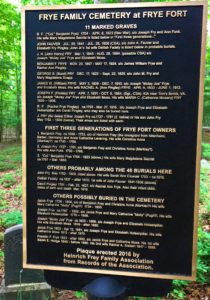
Frederick County Court Order Book 1, p.135
13 Jul 1744
“John Richards in Open Court Acknowledged his deeds of Lease & Release to Benjamin Fry which on his motion is admitted to record.”
Court Order Book 2, p.145
8 Aug 1746 John Richards was ordered to pay both Abraham and Benja. Fry 250#’s tobacco for attending 10 days as an Evidence against Isaac McOwning. A jury trial awarded Richards 5#’s tobacco in a suit against McOwning.
Frey Family Association Journal, Spring 2011, p.26
An article in the FREY JOURNAL, Spring, 2001 attempts to locate the original land of Benjamin Frey. The land of Jost Hite’s was disputed by Thomas Lord Fairfax resulting in a 50 year court battle, which ended in Hite’s favor. Benjamin appears to have had a tract in the Seven Bends area of the north Fork of the Shenandoah near the Bowmans. Fairfax also issued warrants for some of the same land forcing some of the Hite settlers to abandon their claims – among them Benjamin Frey. 168 acres of this North Fork land was sold by Lord Fairfax on 6 May 1749 to William Hubers. Benjamin repurchased this 168 acre tract as evidenced in his Will of 6 Nov 1753 as “the Place that Formerly was William Hovers”. He willed the land to his son Samuel who received a deed from William Hubers & wife on 6 May 1755. This tract was some 25 miles from Benjamin Frey’s home on Cedar Creek.
23 Jul 1747. Moravian missionaries Leonhard Schnell and Vitus Handrup visited with Benjamin Frey, William Frey’s brother, at Cedar Creek. 9 Dec 1749 Schnell and John Brandmueller visited with Benjamin Frey; “Brandmueller had fallen in the Cedar Creek and had become wet, he had an opportunity at Frey’s to dry himself.”
Frederick County Court Order Book 3, p.426
14 May 1751
Benjamin Fry acknowledged his deed of gift to Joseph Fry and Christian the wife of said Benjamin relinquished her right of Dower. On the motion of Joseph admitted to record.
Frey Family Association Journal, Spring 2011, p.28
Will dated Aug 27, 1753 and proved Nov 6, 1753. Wife Cristen to live with son Joseph on the remainder of the homestead [Abraham had previously been deeded 200 acres.] Jacob had already acquired a Fairfax patent for land downstream of his father. Joseph’s deed shows his land bounded both his brother Abraham and Jacob. Executors: sons, Abraham and Henry. Names sons, Jacob, Samuel, Benjamin, William. Daughters: Cristen, Elizabeth. There were bequests of money to Jacob, Benjamin Jr, Cristin, William & Elizabeth – perhaps to equal the distribution to his children. Samuel inherited the 168 acre tract on the North Shanandoah River where he was probably living at the time. Son Henry is know to have owned property in the Capon Valley.
Benjamin Frey’s original will is in the County Clerk’s office. He signed the will himself in English but the letters appear to have been written with difficulty.
Benjamin and Christen are believed to be buried in the family cemetery on the original tract of land along Cedar Creek.
BENJAMIN FREY and REGINA CHRISTENA (?)MARKLEY were married about 1721 in Philadelphia, Philadelphia County, Pennsylvania. REGINA CHRISTENA (?)MARKLEY19,20, daughter of Abraham MARKLEY and Anna Veronica LANDVATTER, was born on 20 March 1699 in Bonfeld, Wuerttenburg, Germany.20 She died in 1760 at the age of 61 in Cedar Creek, Shenandoah County, Virginia.20
The wife of Benjamin is not proved. May have been daughter of Abraham Merklel of Bonfeld, Germany. Wife is also seen as “Anna Christena” and “Christena Anne” and “Christian”. Hank Adams also thinks Benjamin’s wife may have been a sister to the wife of Jost Hite.
Benjamin Frey’s Will names his wife as “beloved wife Cristen”.
Found in an upright file in the Montgomery Co PA Historical Society are records of the Merkle/Markley family which contain the birth of a daughter Regina Christena on 20 Mar 1699. There was also an older sister, Anna Maria, born 16 Jan 1687 – she married Justus Heydt [Jost Hite] on 11 Nov 1704. Benjamin Frey lived adjacent to the Hites in the Falkner Swamp Area, as well as next to Jacob Merkle, brother of these two sisters. The parents of Regina Christena & Anna Maria were Abraham & Anna Veronica Merkle. The choice of the name Abraham for a son of Benjamin & Christen might indicate the boy was named for her father. However, Benjamin also had a probable brother named Abraham.
BENJAMIN FREY and REGINA CHRISTENA ?MARKLEY had the following children:
Abraham Frye, Henry Frye, Jacob Frye, Joseph Fry, Samuel Frye, Benjamin Frye Jr., Christena Anne Frye, and William Frye.
First Generation
Hans Heinrich Frey
(1663-1734)
Mennonite Meeting House Burying Ground, Frederick, Montgomery Co., Pa.
Hans Heinrich Frey was the first German Huguenot pioneer settler in Pennsylvania!
From the Trenton Evening Times newspaper, Wednesday, July 27, 1910: Memorial To A Pioneer — Norristown, Pa. July 27 — A granite memorial tablet is being erected to the memory of Heinrich Frey, the first German Huguenot pioneer, who settled in Pennsylvania, by his descendants, at the Bertolet Mennonite Meeting House and burying grounds at Frederick, Montgomery County, Pa. and will be unveiled at the annual meeting on on Monday, August 1. Heinrich Frey was a native of Althein, Germany, and arrived at New Amsterdam (now New York) in 1675 at the age of 22 years, where he remained among the Holland Dutch settlers for five years, when he and several others came to Philadelphia in the year 1680.
Heinrich Frey was a woodworker, carpenter, and turner, and Abraham Cassel says he turned for Christopher Sowers quite a number of wooden jars with lids to fit while Sowers was in the drug business in Germantown. Some of these jars can be seen among Cassel’s relics. The records show that Frey had become the owner of lot No. 18 in the Germantown Settlement in 1689.
After his marriage he and his father-in-law, Wigard Levering, bought a large tract at Roxborough. He sold to three different persons 100 acres each. Next he moved to Towamencin Township and bought 200 acres in the Falckner Schwamm Valley, 200 acres each for his sons, Jacob and William, and 250 acres for Andrew Frey.
His sons all settled in what is now Montgomery County; Jacob in New Hanover Township; George in Moreland; Benjamin is Skippack, and Abraham, the only exception, in Chester County.
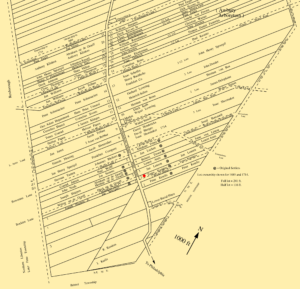
Heinrich Frey is mentioned in the book Year Book of the Pennsylvania Society of New York, pg. 176: “Frederick, Montgomery County – Heinrich Frey Memorial, Granite tablet to the memory of Heinrich Frey, the first German Huguenot pioneer settler in Pennsylvania…
Documented descent from Heinrich Frey would enable a descendant to become a member of the following lineage societies:
First Families of Pennsylvania
Heinrich Frey Family Association
Biography of Heinrich Frey: by Kay Haden* https://sites.rootsweb.com/~katy/fry/index.html
HANS HEINRICH “HENRY’ FREY was born on 17 June 1663 in Altheim, Alsace Province, Germany.5,6 He died in 1734 at the age of 71 in Philadelphia County, Pennsylvania.5 He was buried in Frey-Bertolet Cemetery, Montgomery County, Pennsylvania.7
The Evangelical Church of Altenheim, whose records date back to the 1500’s, had Sippenbuch, or a family history book. There is a Hans Heinrich Frey baptized 17 Jun 1663, whose parents were Jacob Frey and Anna Hirtzeller who had been married 26 Jun 1657. Four other children were baptized.
The father of Jacob was Friedrich Frey of Gunderswill [Gundetswil] in the Canton of Aurich, Switzerland. The father of Anna was Jacob Hirtzeller of Hinterwill, Canton of Aargau, Switzerland.
There are no other entries for a Frey family except the death in 1828 of a Christian Frey, so apparently the family left Altenheim after 1666 when the child Friedrich was baptized.
Update from Hank Adams gives date of birth as 17 June 1663. 1658 was previous date and now seems too early. This new date is a baptism date, not a birthdate. These children of Jacob and Anna Frey appear to have been baptized shortly after their births. It is presumed this is the baby baptized in the Evangelical Church of Altenheim as Hans Heinrich Frey. If he is the same, he came to America at about age 22 and was about 29 when he married 19-year-old Anna Catherine.
Heinrich Frey arrived in Philadelphia on the ship “ffrancis and Dorthea” on 12 Oct 1685 [this date has been changed to emulate New Style dating]; he was listed as the servant of Gerhard Hendrichs who came with his wfie Mary and daughter Sara. Hendrichs was from Krefeld in Germany and had petitioned for his passport in 1679.
The Pennsylvania Magazine of History and Biography, Vol. VIII, 1884, “A Partial List of the Families Who Arrived at Philadelphia Between 1682 and 1687, p.328-340. The original papers said to be in the possession of the Historical Society. [I believe some spelling has been altered in the paper.]
p.337-338
“The ffrancis and Dorothy ffrom London. Richard Bridgeman Commander Arived at Philadelphia the 16th of the 8th month 1685….. Garret Hendrix and Mary his wife and Sarah his Daughter. Henry Fry his servant.”
The introduction to the article states that Penn offered liberal terms to those bringing servants with them to Pennsylvania – each was to have fifty acres when the servant’s time should expire. The servant wasn’t necessarily to perform menial duties – they were often farm hands or skill mechanics or even overseers to act for purchasers that remained in England.
Also on the Frances and Dorothy were the families of Hans Peter Umstadt and Peter Schumacher. Said to have come from the Historical Society of PA Collection, “On 8 May 1685, Gerhardt Hendricks, Hans Peter Umstadt, and Peter Schumacher petitioned the Palatine government at Hockheim for permission to leave Kriegsheim [Krefeld]. Three months later all three men were in Rotterdam signing contracts with Dirck Sipman for land in Germantown, arriving in Philadelphia in October.” It would be very interesting to know how Heinrich Frey became acquainted with this group, and in particular the Hendricks family.
Hans Peter Umstadt brought his wife Barbara, son John, and daughter Margaret and Eve. Peter Shoemaker brought his wife Mary, his daughters Mary & Sarah, his “cousin” [could have been a nephew] Francis and his daughter Gertrude.
Rev. Henry Melchoir Muehlenberg, Lutheran minister, in his report dated 9 Jul 1754 stated, “In the first period, namely from 1680 to 1708, some came by chance, among whom was one Henry Frey, whose wife is said to be still living. He came about the year 1680.”
Frey was naturalized at Germantown, PA, 7 Mar 1691; Wigard Levering, soon to be his father-in-law was in the same group. Record of his marriage in Germantown identifies him as “Henry Frey of Altheim in the province of Alsace in high Germany”. Soon after Heinrich Frey received Lot #18 in Germantown. His Germantown property was acquired by the drawing of lots, owned by the Frankfort Land Company. It was 25 acres, part of 200 granted Johannis Blychers 8 Jun 1683. On 10 Jul 1693, Henry deeded the 25 acres to John Doeden.
The Levering book says Frey bought his land (100 acres), 1 Oct 1692, from John Jennett one of the Patentees. Sold to John George Wood 9 Mar 1729, recorded 27 May 1752 DB H2, p.214. In this deed Heinrich is referred to as a turner, living adjacent to Van Bebbers Township in Philadelphia County.
Heinrich Frey is known to have owned three pieces of property: Germantown, Roxborough [100 acres] and Towamencin [200 acres]. The Towamencin property was bought from one Benjamin Fairman, written 12 Oct 1724, recorded 12 Mar 1743 – the property had passed through several owners but Frey was the first actual settler on the land. The Freys may have settled in Towanmensing Twp as early as 1713 when a survey was made of it for Thomas Fairman.
In 1732, Heinrich Frey and Anna Catharine entered into an article of agreement with several of their children to provide for the necessities of life. 12 Oct 1732. Henry Free, of County of Philadelphia, Yoeman, and Kathrin his wife to Jacob Free of the same place, turner [apparently he turned wooden jars] one of the sons of said Henry & Kathrin and Eliza, Rebecca and Amaly, three of the daughters of said Henry and Kathrin. Do sell unto Jacob all livestock, household goods, etc. In consideration Jacob Free will sufficiently maintain and keep the said Henry & Kathrin with good sufficient and competent meat, drink, washing, lodging, apparel, etc. during their lives and the life of the longer liver of them and will provide and maintain the said Elizabeth, Rebecca and Amaly until they reach the age of eighteen or marriage and give to each of them a legacy or portion as their eldest sisters have had. Signed in the presence of Jacob Levereing: Henry [X] Fry, Kathrin [X] Fry, Elizabet Fry, Rebecka Fry, Amelee Fry, George Fry.
Receipts:
Rec’d 18 Aug 1735 of Jacob Fry the sum of 10 £ becoming due unto the within named Elizabeth Fry now my wife. Signed: Johannes Muller
19 Nov 1737 Rec’d of Jacob Fry, 10 £ due Amely Fry now being my wife. Signed: Frederich Leinbach, Amelia Leinbach
Ann Catharine was still living in 1742 when her father Wigard Levering made his will as he gave to his “daughter Catherine ye sum of tenn pounds”.
Heinrich and Anna are buried in the family cemetery which was on their farm in Towamencin Township. [Charles Burgess, Historian of HFFA as given in Comments & Corrections to Notes on the Twigs of the Tree.]
HANS HEINRICH “HENRY’ FREY and ANNA CATHERINE LEVERING were married on 26 April 1692 in Germantown, Philadelphia County, Pennsylvania.5,8,9 ANNA CATHERINE LEVERING2, daughter of JOHN WIGARD LEVERING and MAGDALENA BOEKER, was born on 15 March 1676 in Mulheim on the Rhur, Bruch, Westphalia, Germany.8,10 She died about 1754 at the age of 78 in Zieglerville (Skippack), Montgomery County, Pennsylvania.3,8
A Lutheran minister, Henry Muhlenberg, was sent from Germany to Philadelphia in 1742. Jul 9 1754, he wrote, “In the first period, namely from 1680 to 1708, some came by chance, among whom was one Henry Frey, whose wife is said to be still living. He came about the year 1680.”
Anna Catherine’s parents were John Wigard Levering and Magdalena Boeker.
Between 1671 and 1685, they lived in Wesel, Gemen, and Mulheim, Germany. They immigrated to Germantown PA in 1685, and moved to Roxborough in 1692.
Levering is probably buried upon his farm which became the churchyard and burial ground of the Baptist Church, organized in 1789; now known as Leverington Cemetery.
His will of 23 Aug 1742 named Catherine – Anna Catherine who married Heinrich Frey. In a prior will, dated 10 May 1735, she was named as Catherine Frey.
Heinrich Frey and Anna Catherine Levering had the following children: William Frey, Benjamin Frey, Elizabeth Catherine Frey, Henry Frey, Abraham Frey, John Frey, George Frey, Jacob Frey, Amelia Elizabeth Frey, Rebecca Frey, and Elizabeth Frey.
My ancestor Andris Souplis witnessed marriage of Heinrich Frey
My line of descent from Heinrich Frey:
1. Heinrich Frey, b. 1663 in Alsace Province, Germany; d. 1734 Skippack, Montgomery Co., PA
2. Benjamin Frey, b. 1696 in PA; d. 1753 in Frye’s Fort, Frederick Co., VA
3. Abraham Frye, b. 1722 in Philadelphia, PA; d. 1807, Fallowfield, Washington Co., PA – DAR Patriot!
4. James Fry, b. 1759 in VA; d. 1821 in Pike Co., MO
5. Jacob Fry, b. 1793 in Bourbon Co., KY; d. 1850 in Pike Co., MO
6. William Fry, b. ca. 1822 in KY; d. Feb. 1850 in Pike Co., MO
7. James Franklin “Frank” Fry, b. 2 Mar 1850 Pike Co., MO; d. 1909 in Lincoln Co., MO
8. Lewellen Fry, b. 1877 in Pike Co., MO; d. 1920 in Lincoln Co., MO married DeWitt Clinton Hatfield
9. Ora Ezrah Hatfield, b. 1897 in Lincoln Co., MO; d. 1944 in San Francisco, CA (name at death: Edward Melvin Hatfield)
10. Edsel Hatfield, b. 1919 in Madison Co., IL; d. 2007 in St. Louis, MO
11. Elaine Marie Hatfield ME
